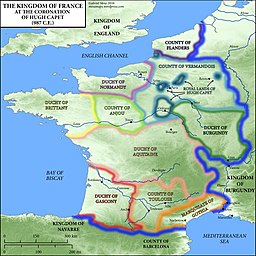Birth of Capetian dynasty
History of France between 987 AD - 1179
The Capetian dynasty, also known as the House of France was founded by Hugh Capet. It is among the largest and oldest royal houses in Europe and the world and ruled the Kingdom of France from 987 to 1328. The dynasty had a crucial role in the formation of the French state. Hugh Capet’s rule was limited to his own domain around Paris, while the rest of the French kingdom was in the hands of powerful local lords. His direct successors gradually increased the territory over which they had control through conquest and inheritance and also by skillfully exploiting their rights as suzerains in areas not under their direct authority. Under the Capetians, many of the basic administrative institutions of the French monarchy, including Parlements (royal law courts), the States General (representative assembly), and the baillis (royal local officials), began to develop.
The history of medieval France starts with the election of Hugh Capet (940–996) by an assembly summoned in Reims in 987. He was recorded to be recognised king by the Gauls, Bretons, Danes, Aquitanians, Goths, Spanish and Gascons. The new dynasty was in immediate control of little beyond the middle Seine and adjacent territories, while powerful territorial lords such as the 10th- and 11th-century counts of Blois accumulated large domains of their own through marriage and through private arrangements with lesser nobles for protection and support.
Under King Philip I, the kingdom enjoyed a modest recovery during his extraordinarily long reign (1060–1108). His reign also saw the launch of the First Crusade to regain the Holy Land, which heavily involved his family although he personally did not support the expedition. An important part of the French aristocracy also involved itself in the crusades, and French knights founded and ruled the Crusader states. An example of the legacy left in the Middle East by these nobles is the Krak des Chevaliers' enlargement by the Counts of Tripoli and Toulouse.
By far the greatest threat to the royal dynasty came from the neighbouring counts of Anjou, who by judicious marriages become the Plantagenet rulers of England, Normandy and much of western France. The Norman conquest of England introduced a new situation in northwest Europe. Lands on both sides of the English Channel were from this time under the control of a single dynasty. The kings of England were also the dukes of Normandy. A Norman-French royal family crowned in Westminster seek to extend its territories on the French side of the water. At the same time a Frankish-French royal family strived to assert its authority over the whole geographical region of France. The result is a prolonged struggle, eventually spanning some four centuries, in which the identities of medieval Europe's two strongest kingdoms are gradually shaped.
The princes of the two houses married within the same limited circle, so western Europe became an interconnected web of French-speaking cousins - often with good claims to each other's territories. Louis VII and Henry II set a powerful example, as kings of France and England who married the same heiress from Aquitaine. But the point can be made almost equally well among their successors.
References: Wikipedia, History World
Previous historical period: Frankish kingdoms (486-986) | Next historical period: Late Capetians (1180-1328)Popular sites founded between 987 AD and 1179 in France
Notre Dame de Paris
Paris, France
1163
Strasbourg Cathedral
Strasbourg, France
1015-1469
Cháteau Comtal
Carcassonne, France
c. 1130
Chartres Cathedral
Chartres, France
1145-1260
St. Trophime Church
Arles, France
c. 1100
Saint-Germain l'Auxerrois
Paris, France
12th century
Abbey of Saint-Germain-des-Prés
Paris, France
1014
Bordeaux Cathedral
Bordeaux, France
1096
Monolithic Church of Saint-Emilion
Saint-Émilion, France
12th century
Saint Laurent Church
Marseille, France
12th century
Saint-Martin-des-Champs Priory
Paris, France
1135
Basilica of Saints Nazarius and Celsus
Carcassonne, France
1096
Fontevraud Abbey
Fontevraud-l'Abbaye, France
1110
Château du Haut-Koenigsbourg
Orschwiller, France
12th century
Bayeux Cathedral
Bayeux, France
1077
Basilica of St. Sernin
Toulouse, France
1080-1120
Nice Castle Hill
Nice, France
11th century
Saint-Malo Cathedral
Saint-Malo, France
1146
Pont d'Avignon
Avignon, France
1177-1185
Basilica of St. Denis
Seine-Saint-Denis, France
12th century
St. Faith's Church
Sélestat, France
1170-1180
Laon Cathedral
Laon, France
c. 1160
Musée Picasso
Antibes, France
11th century / 1966 (museum)
Aix Cathedral
Aix-en-Provence, France
12th century
Featured Historic Landmarks, Sites & Buildings
Historic Site of the week
Argos Theater
The ancient Argos Theater was built in 320 BC. and is located in Argos, Greece against Larissa Hill. Nearby from this site is Agora, Roman Odeon, and the Baths of Argos. The theater is one of the largest architectural developments in Greece and was renovated in ca 120 AD.
The Hellenistic theater at Argos is cut into the hillside of the Larisa, with 90 steps up a steep incline, forming a narrow rectilinear cavea. Among the largest theaters in Greece, it held about 20,000 spectators and is divided by two landings into three horizontal sections. Staircases further divide the cavea into four cunei, corresponding to the tribes of Argos A high wall was erected to prevent unauthorized access into the theatron and may have helped the acoustics, but it is said the sound quality is still very good today.
Around 120 CE, both theaters were renovated in the Roman style.
